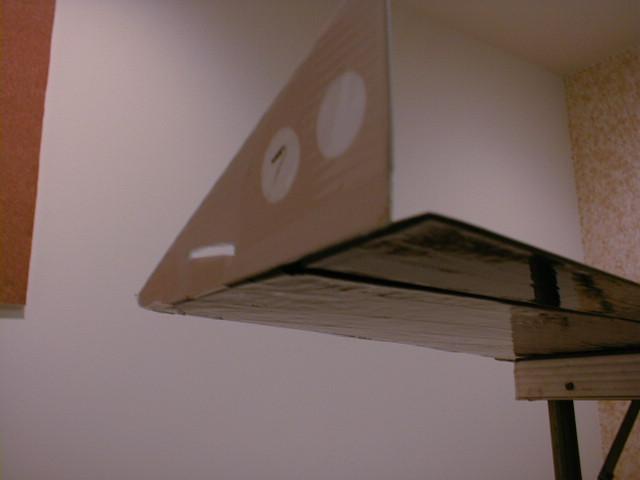
Flying V Set-up
Make sure the clevises are attached to the top hole of the elevon control horns and the control rods are attached to the top hole of the servo control horns. Center your transmitter trims, turn your transmitter on, connect a battery to the ESC, and turn the ESC on (if applicable). Make sure the elevons move in the proper directions when the stick is moved. Turn the ESC off, then adjust the servo control horns so that they're approximately perpendicular to the top of the wing. Adjust the clevises so that the elevons follow the bottom foil. Turn the ESC back on, then add about 3-4 clicks of up trim. The throws should be about 5/8" in each direction for both pitch and roll control.

Mark the bottom of the wing at 7" from the nose. Get the wing ready to fly -- use a 7 cell battery if you have one. Attach a pencil to the bottom of the wing at the 7" mark, perpendicular to the root chord. Or use a CG jig like the one shown in the picture (two 1/4" dowels in a wood base). Add nose weight (or tail weight) until it balances. I find that setting the CG at 7.1" from the nose is optimum for my level of ability. My wing needed about 1/2 oz. of weight to get the CG at 7.1" from the nose.

Make sure you're in a large, open, uncrowded area. Perform a range check and give the wing a final check -- check the control throws, CG, reflex, and that the elevons are not binding. Without the motor running, give the wing a good toss forward, straight ahead into the wind -- the goal is to trim the wing for a straight glide with smooth decent. Be ready to correct for flight path deviations! If the wing noses up and seems to "mush" down to the ground, try reducing the reflex by adding 1-2 clicks of down trim. If the wing hits the dirt prematurely, add 1-2 clicks of up trim. If you noticed that pitch control seemed too sensitive, add a little (1/4 oz.) nose weight. If pitch control seemed sluggish, remove a little nose weight. Adjust roll trim if needed. Repeat the steps above until the wing glides 25 feet with a good toss and pitch control is to your liking. The wing may glide a bit farther if you let it fly a bit faster.
Perform another range check, but with the motor on (you'll need a buddy to hold the wing). Make sure motor noise is not interfering with the radio signal. Cut throttle and give the wing a toss as before. Wait a second after the wing has left your hand, then throttle up to full and climb. Get three mistakes high (maybe 150 ft.), throttle back until the wing is flying level and try making some turns at different bank angles. Adjust trims as needed. Climb a bit more and then cut throttle. Pull the nose up until the wing stalls. Make sure the stall recovery of the wing suits your flying style. Moving the CG towards the nose will cause the wing to recover more quickly from a stall. However, if the CG is too far forward, the wing could go into another stall. Land the wing dead stick, into the wind.
Once you're happy with the setup, the real fun begins! I've been able to fly the Flying V in 25 mph winds, do outside loops (from upright and inverted flight), vertical rolls, high speed diving passes, tight loops and turns -- it even thermals a bit! I hope that you are as pleased with the performance of this wing as I am.
Happy Flying!
